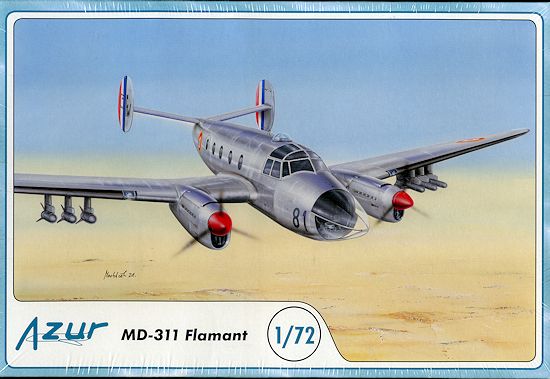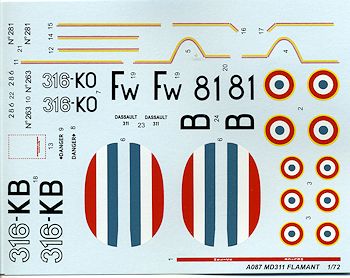
Azur 1/72 Dassault MD. 311 Flammant
| KIT #: | A087 |
| PRICE: | $19.46 on sale ($35.00 SRP) |
| DECALS: | Three options |
| REVIEWER: | Scott Van Aken |
| NOTES: | Short run with resin and photo etch parts |

| HISTORY |
Design work on a twin-engined light transport started in 1946 with the MD 303, a development of an earlier project for an eight-seat communications aircraft the Marcel Bloch MB-30. The prototype MD 303 first flew on 26 February 1947 powered by two Béarn 6D engines, designed to meet a French Air Force requirement for a colonial communications aircraft. A re-engined version was ordered into production at the new Dassault factory at Bordeaux-Mérignac. The production aircraft was a low-wing monoplane with twin tail surfaces and a a tri-cycle undercarriage and powered by two Renault 12S piston engines.
Three main versions of the aircraft now named Flamant (means Flamingo in French) were produced. The MD 315 10-seat colonial communication aircraft (first flown on 6 July 1947), the MD 312 six-seat transport aircraft (first flew on 27 April 1950), and the MD 311 navigation trainer (first flew on 23 March 1948. The MD 311 had a distinctive glazed nose for its role as both a bombing and navigation trainer.
The first Flamant was delivered to the French Air Force in 1949 and deliveries of all versions was completed by 1953
The aircraft was used for pilot training, transport, maritime surveillance and bombing. During the Algerian War of Independence the plane was used for light attack with SS11 missiles or with machine guns, bombs, and rockets. The Flamant stayed in service until 1981. In addition to the French air force, the Flamant served in Cambodia, Madagascar, Tunisia, and Vietnam.
| THE KIT |
 Another
interesting kit from Azur. They usually concentrate on French subjects and this
is one that I'm quite pleased to see kitted. The MD311 and its brethern were seen all over the
place in the 1950s-1970s. Some were in training units, some were squadron hacks and some were
station hacks. Many had large international orange bands n them that were quite
colorful when the paint was fresh.
Another
interesting kit from Azur. They usually concentrate on French subjects and this
is one that I'm quite pleased to see kitted. The MD311 and its brethern were seen all over the
place in the 1950s-1970s. Some were in training units, some were squadron hacks and some were
station hacks. Many had large international orange bands n them that were quite
colorful when the paint was fresh.
This kit is quite typical of the MPM family of short run kits. There are resin parts and a few photo-etch as well. Thankfully, most of the vac canopy kits are done and this one has injected clear plastic for those bits. The kit includes the solid nose and shorter wing tips of the other versions.
Molding is quite good with no real problem areas to speak of. The resin parts are for the interior chairs, engine fronts, exhaust and a few small scoops and other outside bits. Photo etch is used for the instrument panel and seat harnesses in the cockpit. There is also an acetate piece for behind the panel. Since one of the options is armed, this kit comes with pylons and SS11 missiles, items not provided with the other boxing.
Instructions are quite nicely done with lots of well drawn construction steps and a few detail drawings to help out. This one will be a tail sitter and thanks to the clear nose, there is not much room to put weight. Most will really pack in the area behind the cockpit, though that will be seen when looking into the cabin.
 Gunze paint
references are provided. Markings are
provided for three aircraft, all in overall aluminum. I believe these planes
were mostly unpainted but after a while, they were given a coat of aluminum
paint. The first option is one without any bands on it as based in Algeria and
used during the Algerian revolution in 1959. Next is a plane of l'ELA 41 in
1963/64. This has the daglo bands on the wings, tail and nose area. I find it a
bit odd that it has the coding from G.E. 316 on the fuselage, but there you have
it. No tricolor rudder bands unlike the first and next option. The third option
is with G.E. 316 in 1969/1970 and retains the tricolor rudder stripes along with
the various bands. The decal sheet is nicely printed and should prove to be very
thin and opaque.
Gunze paint
references are provided. Markings are
provided for three aircraft, all in overall aluminum. I believe these planes
were mostly unpainted but after a while, they were given a coat of aluminum
paint. The first option is one without any bands on it as based in Algeria and
used during the Algerian revolution in 1959. Next is a plane of l'ELA 41 in
1963/64. This has the daglo bands on the wings, tail and nose area. I find it a
bit odd that it has the coding from G.E. 316 on the fuselage, but there you have
it. No tricolor rudder bands unlike the first and next option. The third option
is with G.E. 316 in 1969/1970 and retains the tricolor rudder stripes along with
the various bands. The decal sheet is nicely printed and should prove to be very
thin and opaque.
| CONCLUSIONS |
So there you have it. Another interesting type that we never thought we'd see kitted. It will make for a fairly large model when done and look nice on your shelves.
| REFERENCES |
http://en.wikipedia.org
2013 Thanks to me for getting this one on sale.
If you would like your product reviewed fairly and fairly quickly, please
contact
the editor or see other details in the
Note to
Contributors.